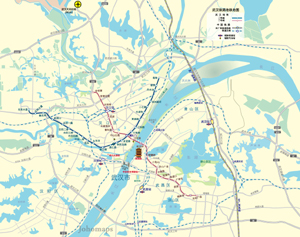|
Other names of Wuhan:
Hanyang-Hankou-Wuchang (Wuhan is a consortium of the three
cities)
Jiangcheng (江城)
Short form: Not applicable
Wuhan (From Wikipedia)
Copyright owned by wikipedia.org
See
here for copyright and licensing conditions
Wuhan (Simplified
Chinese: 武汉; Traditional
Chinese: 武漢; Hanyu
Pinyin: Wǔhŕn)
is the capital of Hubei
province, and is the most populous city in central China.
It lies at the confluence of the Yangtze
and Han
River. It has a population of approximately 8,310,000 people. In the 1920s,
Wuhan was the capital of a leftist Chinese
Nationalist government led by Wang
Jingwei in opposition to Chiang Kai-shek.
History
The area was first settled more than 3,000 years ago. During the
Han
Dynasty, Hanyang became a fairly busy port. In the 3rd century AD,
walls were built to protect Hanyang (AD 206)
and Wuchang (AD 223).
The latter event marks the foundation of Wuhan. In AD 223,
the Yellow
Crane Tower (黄鹤楼) was constructed on the
Wuchang side of the Yangtze River. Cui
Hao, a celebrated poet of Tang Dynasty, visited the building in the early 8th Century; his poem
made the building the most celebrated building in southern China. The
city has long been renowned as a center for the arts (especially poetry)
and for intellectual studies. Under the Mongol ruler (Yuan
Dynasty), Wuchang was promoted to the status of provincial capital.
By approximately 300 years ago, Hankou had become one of the country's
top four trading towns.
In the late 1800s railroads were extended on a north-south axis
through this city, which then became an important transhipment point
between rail and river traffic. At this time foreign powers extracted
mercantile concessions, with the riverfront of Hankou being divided up
into various foreign controlled merchant districts. These districts
contained trading firm offices, warehouses, and docking facilities.
In 1911, Sun
Yat-sen's followers launched the Wuchang
Uprising that led to the collapse of the Qing
Dynasty and the establishment of the Republic
of China. Wuhan was the capital of a leftist Kuomintang
government led by Wang
Jingwei in opposition to Chiang Kai-shek during the 1920s.
The city has been subject to numerous devastating floods, which are
supposed to be controlled by the ambitious Three
Gorges Dam. That project is set to be completed in 2009, but is
plagued by environmental, technical, and social issues.
|

